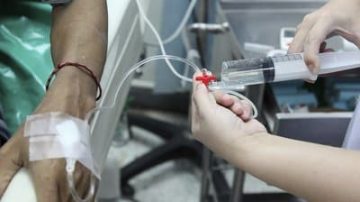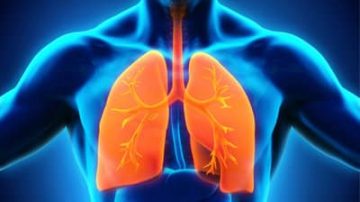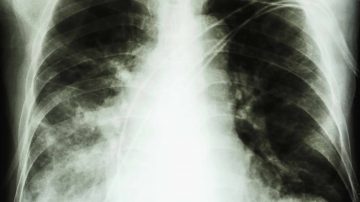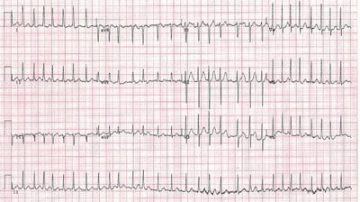Lumbar puncture (LP), commonly performed in infants to rule out meningitis, is often not successful in the hands of inexperienced operators. Investigators conducted a study of 128 infants younger than 6 months. They compared traditional LP to LP preceded by…
Read MoreIn Australia, investigators analyzed 573 random adults from three emergency departments (EDs). These patients were to receive ketofol (a 1:1 mixture of ketamine and propofol) or propofol prior to a painful procedure. Initially, ketofol was administered intravenously at 0.25 mg/kg…
Read MoreAfter three defibrillation attempts, recommendations state that amiodarone or lidocaine may be considered for patients with cardiac arrest and persistent shockable rhythm. A randomized, controlled trial was conducted and showed there was no significant difference between amiodarone and lidocaine and…
Read MoreInvestigators have conducted a secondary analysis in order to identify predictors of difficult or prolonged intubation with hypercurved videolaryngoscopes. The analysis was of a randomized control trial of 1100 elective surgery patients. After anesthesia and neuromuscular blockade, these patients were…
Read MoreMore Tags – Computed tomography, CT scans, HPC updates, Magnetic resonance imaging, MRI, Spine Injury
The majority of intoxicated patients with a possible cervical spine injury remain in a cervical collar or undergo magnetic resonance imaging (MRI). This approach is preferred since computed tomography (CT) exams alone are insensitive for detecting ligamentous injuries. A study…
Read MoreThis systematic review shows a high rate of pulmonary embolism (PE) in patients hospitalized for chronic obstructive pulmonary disease (COPD) exacerbations. Symptoms of PE can overlap with those of acute exacerbations of chronic obstructive pulmonary disease (COPD) making the diagnosis…
Read MoreAre MRSA Antibiotics Overprescribed for Community-Acquired Pneumonia? – NEJM Journal Watch Nearly 30% of hospitalized CAP patients received antibiotics for MRSA, even though fewer than 1% had MRSA-associated CAP. A recent multicenter, prospective, active-surveillance study of 2259 patients hospitalized with…
Read MoreIt has always been a therapeutic dilemma whether to anticoagulate patients with Afib and a history of prior intracranial hemorrhage (ICH). This study used a Taiwanese national database to identify 12,917 patients with an ICH history and new AF and…
Read MoreMore Articles – Emergency Procedures, Lumbar Puncture, medical procedures, Neurological diseases, Traumatology
Traumatic lumbar puncture (LP) is fairly common and occurs when the needle causes bleeding into the subarachnoid space. Introduction of peripheral red blood cells (RBCs) in cerebrospinal fluid (CSF) increases CSF protein levels, thereby complicating diagnosis of bacterial meningitis. This…
Read MoreThis population-based cohort study between 2000 and 2012 from the UK’s Health Improvement Network database compared diagnoses between 275,000 adults who had been prescribed corticosteroids and 626,000 who had not been prescribed corticosteroids. The query was whether corticosteroid recipients had…
Read MoreObesity hypoventilation syndrome (OHS) is defined by the triad of obesity (BMI >30 kg/m2), daytime hypoventilation (Paco2 >45 mm Hg), and sleep-disordered breathing in the absence of other causes of hypercapnia, such as severe obstructive lung disease, severe interstitial lung…
Read MoreTargeting to 88%–92% did not cause harm. There is little data on ventilator weaning when it comes to oxygenation goals. Many intensivists adjust the ventilator to maintain an oxygen saturation of at least 95% to buffer against desaturation. However, there…
Read MoreThe anti-Xa anticoagulant lowers bleeding and death rates in a routine clinical care setting. In patients with non–ST-segment elevation myocardial infarction (NSTEMI), the factor Xa inhibitor fondaparinux was noninferior to enoxaparin in reducing ischemic outcomes in the OASIS-5 study. In…
Read MorePrevious trials have investigated the use of B-type natriuretic peptide (BNP) to assess patients with dyspnea in the ED. The sentinel trial was the BNP (Breathe Not Properly) trial that evaluated nearly 800 patients presenting to the ED with complaints…
Read MoreTarget Audience: Emergency clinicians Background: A multidisciplinary group of emergency physicians, radiologists, cardiologists, and others has developed appropriateness criteria for the use of imaging to help inform clinicians for four clinical scenarios presenting as chest pain in the ED. Key…
Read MoreCategories
- ACLS (1)
- Arterial line (33)
- Cardiovascular diseases (77)
- Central line (55)
- Chest Tube (39)
- Dermatology (4)
- Emergency Procedures (139)
- Endocrinology (6)
- Endotracheal Intubation (36)
- Events (24)
- FAST Exam (12)
- Featured (113)
- Featured Procedure (42)
- Gastrointestinal diseases (32)
- Ginecology (3)
- Glidescope Intubation (21)
- Hematology (33)
- Hospital Procedures (85)
- Infections (32)
- Intraosseous line (8)
- King Tube (27)
- Laryngeal Mask Airway (18)
- Lumbar Puncture (36)
- Mechanical Ventilation (34)
- Medical General (95)
- medical procedures (258)
- Needle Decompression (6)
- Nephrology (11)
- Neurological diseases (12)
- Oncology (4)
- Paracentesis (32)
- Pericardiocentesis (3)
- Procedural Sedation (19)
- Respiratory diseases (85)
- RUSH Exam (8)
- Thoracentesis (37)
- Traumatology (24)
- Travel (27)
- Ultrasound-Guided Peripheral IV (13)















